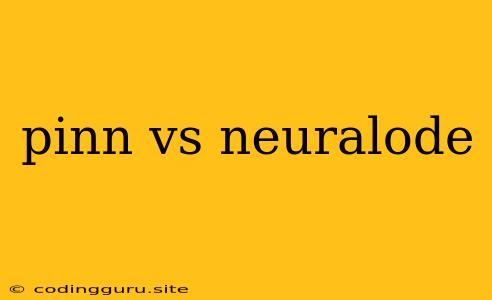Choosing the Right AI Tool for Your Needs: PINN vs. NeuralODE
In the dynamic world of artificial intelligence (AI), numerous tools and techniques are constantly emerging, each promising unique advantages for specific applications. Among these, PINN (Physics-Informed Neural Networks) and NeuralODE (Neural Ordinary Differential Equations) stand out as powerful approaches for solving complex problems in various fields.
Both PINN and NeuralODE leverage the capabilities of neural networks, but they differ significantly in their underlying principles and applications. This article delves into the core differences between these two methods, helping you understand their strengths and limitations to make informed decisions about which tool best suits your specific needs.
What is PINN?
PINN is a deep learning technique that combines neural networks with physical laws and equations. It aims to solve partial differential equations (PDEs) by incorporating prior knowledge about the underlying physics into the training process.
Essentially, a PINN is trained to approximate the solution of a PDE by minimizing a loss function that includes both the PDE residuals and the boundary conditions.
Here's how it works:
- The neural network acts as a function approximator, mapping input variables to the corresponding output values.
- The physical laws are incorporated as constraints during the training process.
- The loss function is designed to minimize both the error in satisfying the PDE and the error in meeting the boundary conditions.
Advantages of PINN:
- Improved accuracy: PINN can achieve high accuracy by leveraging the physics embedded in the model.
- Data efficiency: PINN requires less training data compared to traditional data-driven approaches, as it learns from both data and the underlying physical principles.
- Handling complex problems: PINN can be applied to solve complex PDEs with high dimensionality and challenging boundary conditions.
Limitations of PINN:
- Computational cost: Training PINN models can be computationally expensive, especially for complex problems.
- Limited generalization: PINN models may not generalize well to unseen data outside the training domain.
What is NeuralODE?
NeuralODE is a deep learning technique that utilizes neural networks to approximate the solutions of ordinary differential equations (ODEs). It leverages the expressive power of neural networks to represent complex dynamics in a continuous manner.
Here's how it works:
- A neural network is trained to learn the parameters of the ODE, which defines the evolution of the system over time.
- The ODE solver integrates the neural network-based ODE to predict the future state of the system.
- The loss function is used to minimize the difference between the predicted and actual states.
Advantages of NeuralODE:
- Flexibility and expressiveness: NeuralODE can model complex and nonlinear systems with high accuracy.
- Handling time-series data: It is particularly suitable for solving problems involving time-dependent phenomena.
- Reduced memory consumption: NeuralODE can be trained efficiently with limited computational resources.
Limitations of NeuralODE:
- Limited to ODEs: NeuralODE is only applicable to ODE problems and cannot handle PDEs directly.
- Sensitivity to initial conditions: The accuracy of NeuralODE solutions can be sensitive to the initial conditions of the ODE.
PINN vs. NeuralODE: A Head-to-Head Comparison
| Feature | PINN | NeuralODE |
|---|---|---|
| Problem Type | PDEs | ODEs |
| Prior Knowledge | Integrates physical laws | Does not require explicit physical knowledge |
| Data Requirements | Relatively low | Can be data-driven or physics-based |
| Computational Cost | Generally high | Typically lower than PINN |
| Applications | Fluid mechanics, heat transfer, structural mechanics | Time series prediction, robotics, control systems |
When to Choose PINN or NeuralODE?
The choice between PINN and NeuralODE depends heavily on the specific problem you're tackling. Consider the following factors:
- Type of equation: If your problem involves PDEs, PINN is a strong contender. If you are dealing with ODEs, NeuralODE might be a better option.
- Availability of physical knowledge: PINN benefits from incorporating physical laws, while NeuralODE is more data-driven. If you have a good understanding of the underlying physics, PINN might be preferred. If you have limited physical knowledge, NeuralODE can be more flexible.
- Data availability and computational resources: PINN typically requires less data but may be more computationally expensive. NeuralODE might be more suitable if you have ample data and limited computational resources.
Example Applications
PINN:
- Predicting the behavior of turbulent flows in fluid mechanics.
- Simulating the diffusion of heat in materials.
- Analyzing the stress and strain distributions in structures.
NeuralODE:
- Forecasting stock prices in finance.
- Controlling robotic arms in robotics.
- Modeling the dynamics of chemical reactions in chemical engineering.
Conclusion
Both PINN and NeuralODE offer valuable approaches to solving complex problems in diverse domains. PINN excels in integrating physical knowledge into neural network models for solving PDEs, while NeuralODE excels in modeling complex dynamics of ODEs.
Choosing the right tool depends on your specific needs and the characteristics of the problem you are trying to solve. Understanding their strengths and limitations will enable you to make informed decisions and leverage the power of these advanced techniques for your AI applications.
